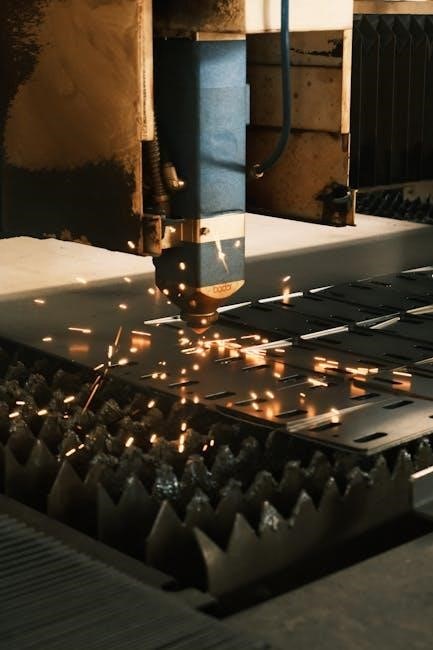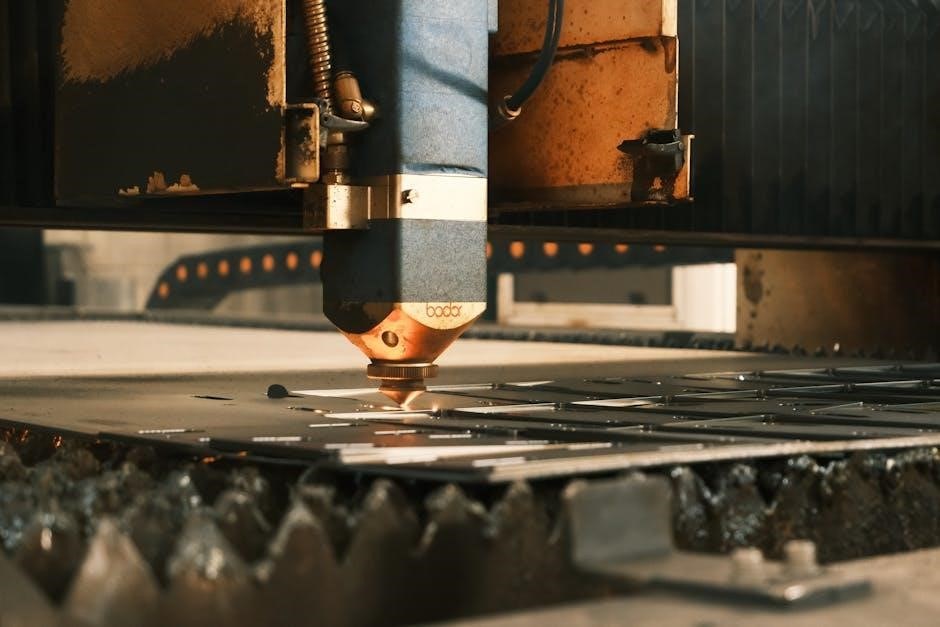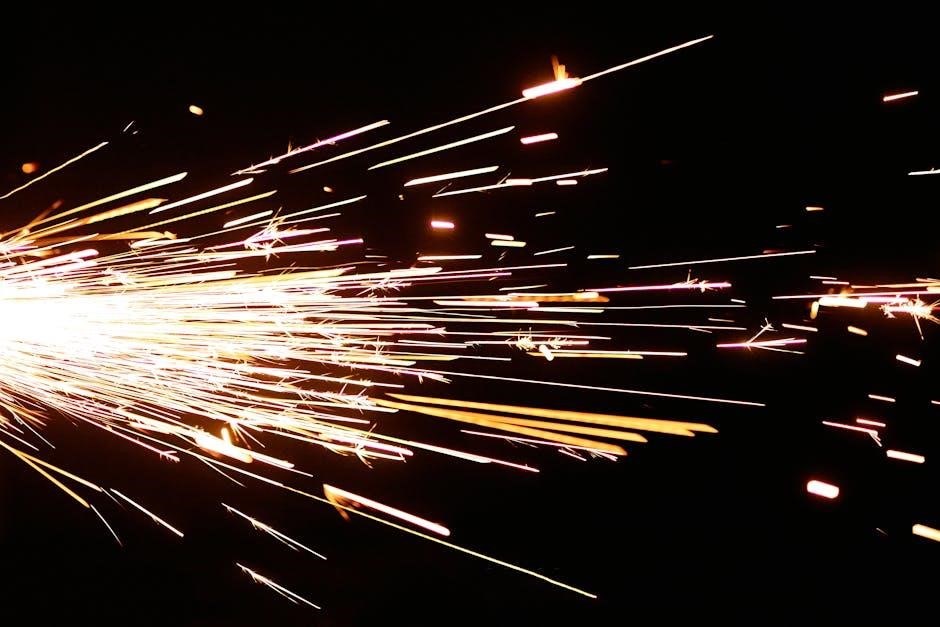Welcome to the 12th edition of Modern Welding, a comprehensive guide offering updated techniques, safety protocols, and advanced materials for welders of all skill levels․ This edition emphasizes digital learning tools and real-world applications to enhance welding education and practice․
Overview of the Modern Welding Textbook
The 12th edition of Modern Welding serves as a cornerstone for welding education and practice, offering a detailed exploration of welding principles, processes, and applications․ This textbook is designed to cater to both beginners and experienced welders, providing a clear, structured approach to learning․ It covers fundamental concepts, safety protocols, and advanced techniques, ensuring a comprehensive understanding of modern welding․ The book is organized into chapters that progressively build skills, from basic equipment setup to complex welding processes․ With a focus on practical applications and real-world scenarios, the 12th edition incorporates updated industry standards, materials, and technologies․ It also includes visual aids, practice exercises, and case studies to enhance learning and retention, making it an essential resource for anyone involved in welding․
Key Features of the 12th Edition
The 12th edition of Modern Welding offers enhanced coverage of welding processes, including updated techniques for Gas Tungsten Arc Welding (GTAW) and Shielded Metal Arc Welding (SMAW)․ It features detailed explanations of welding safety, personal protective equipment, and adherence to safety standards․ The textbook includes high-quality images, diagrams, and step-by-step instructions to aid learning․ New to this edition are digital learning tools, such as interactive simulations and video tutorials, designed to engage students and improve skill mastery․ Additionally, the book provides practical insights into welding applications across industries like automotive, aerospace, and construction․ With a focus on modern materials, including carbon steel, stainless steel, and aluminum alloys, this edition is a versatile resource for both beginners and experienced welders․
Safety in Welding
Safety in welding is crucial for protecting workers from hazards․ This section covers essential PPE, safety standards, and best practices to ensure a secure working environment․ The 12th edition emphasizes adherence to regulations and proper equipment maintenance․
Personal Protective Equipment (PPE)
Personal Protective Equipment (PPE) is essential for safeguarding welders from hazards such as intense heat, sparks, and harmful fumes․ The 12th edition of Modern Welding emphasizes the importance of proper PPE, including welding helmets with shaded lenses, heat-resistant gloves, and flame-resistant clothing․ Safety glasses or goggles provide additional eye protection, while respirators or air-purifying masks are crucial in environments with airborne contaminants․ The textbook also highlights the need for durable, non-conductive footwear to prevent electrical shock․ By adhering to PPE guidelines, welders can minimize risks and ensure a safer working environment․ This section underscores the critical role of PPE in modern welding practices, aligning with industry safety standards to protect professionals across various applications․
Safety Standards and Regulations
Safety standards and regulations are critical in welding to protect workers and ensure compliance with legal requirements․ The 12th edition of Modern Welding emphasizes adherence to established safety protocols, such as those set by OSHA and AWS․ These guidelines cover proper equipment maintenance, ventilation, and personal protective gear․ The textbook also highlights the importance of hazard assessments and emergency preparedness․ By following these regulations, welders can minimize risks and create a safer working environment․ The 12th edition provides updated information on industry-specific standards, ensuring welders are well-informed about current safety practices and compliance requirements․ This section is essential for both novice and experienced welders to uphold safety standards in their profession․

Welding Equipment and Tools
Modern welding employs a variety of specialized tools, including GTAW and SMAW equipment, power sources, and consumables․ Proper selection and maintenance ensure safety and efficiency․
Gas Tungsten Arc Welding (GTAW) Equipment
Gas Tungsten Arc Welding (GTAW) equipment is essential for achieving high-quality welds, particularly in industries requiring precision and cleanliness․ The core components include a TIG torch, welding power source, and inert gas supply system․ The 12th edition of Modern Welding details advancements in GTAW equipment, such as improved high-frequency arc starters and digital control systems․ It also covers the importance of proper torch maintenance, including tungsten electrode preparation and shielding gas flow management․ Additionally, the textbook emphasizes the role of cooling systems, such as water-cooled torches, to prevent overheating during prolonged welding operations․ Understanding GTAW equipment setup and operation is critical for mastering this versatile welding process․
Shielded Metal Arc Welding (SMAW) Equipment
Shielded Metal Arc Welding (SMAW) relies on a power source, electrodes, and shielding to produce high-quality welds․ The equipment includes a welding machine, electrode holder, and protective gear like helmets and gloves․ Electrodes are coated with flux to protect the weld from contamination and are available in various materials for different metals․ The power source can be AC or DC, depending on the application․ SMAW equipment is durable, portable, and widely used in construction and repair work due to its versatility․ Proper setup and maintenance ensure consistent results and safety․ This equipment is essential for achieving strong, reliable welds in diverse environments․

Welding Processes and Techniques
This section explores advanced welding methods, including GTAW, SMAW, and GMAW, detailing techniques for precise, high-quality welds in various materials and applications․ Clear instructions guide both novices and experts․
Gas Tungsten Arc Welding (GTAW) Techniques
Gas Tungsten Arc Welding (GTAW) is a highly precise welding process that uses a non-consumable tungsten electrode to produce high-quality welds․ The 12th edition of Modern Welding provides detailed insights into GTAW techniques, emphasizing equipment setup, shielding gas selection, and arc control․ It covers strategies for achieving clean, slag-free welds and minimizing distortion․ The textbook also explores the use of GTAW in various industries, including aerospace and automotive, where high-purity and visually appealing welds are critical․ Advanced techniques, such as pulse welding and oscillation methods, are discussed to enhance productivity and weld integrity․ This section is tailored for both novice and experienced welders, offering practical tips for mastering GTAW in high-integrity applications․
Shielded Metal Arc Welding (SMAW) Techniques
Shielded Metal Arc Welding (SMAW), also known as “stick” welding, is a versatile process covered extensively in the 12th edition of Modern Welding․ The textbook highlights proper electrode selection, arc striking techniques, and maintaining consistent arc length for high-quality welds․ It emphasizes the importance of joint preparation and cleanliness to ensure strong, defect-free joints․ The book also details how to manage slag removal and control heat input to prevent warping․ Advanced techniques, such as welding in multiple positions (flat, horizontal, vertical, and overhead), are explored to broaden skill sets․ Best practices for equipment setup and safety protocols are included to ensure efficient and safe SMAW operations․ This section serves as a comprehensive guide for mastering SMAW in various industrial and construction applications․
Gas Metal Arc Welding (GMAW) Techniques
Gas Metal Arc Welding (GMAW), also known as MIG welding, is a highly efficient and versatile process․ It uses a continuous wire electrode fed through a welding gun, producing a clean and consistent weld․ The 12th edition highlights proper techniques, including equipment setup, wire selection, and shielding gas choices․ Key steps involve maintaining the correct angle and travel speed to ensure penetration and quality․ The textbook emphasizes troubleshooting common issues like porosity and lack of fusion․ GMAW is widely used in automotive and industrial applications due to its speed and adaptability․ This section provides detailed guidance for mastering GMAW, ensuring welders can achieve professional results across various materials and thicknesses․

Metals and Materials in Welding
Explore the properties and applications of carbon steel, stainless steel, and aluminum alloys in welding․ Learn techniques for working with diverse metals to achieve optimal results․
Carbon Steel Welding
Carbon steel welding is a fundamental process in modern welding, widely used due to its strength, durability, and cost-effectiveness․ The 12th edition of Modern Welding provides detailed insights into welding various carbon steel grades, emphasizing proper techniques to avoid defects․ Shielded Metal Arc Welding (SMAW) and Gas Metal Arc Welding (GMAW) are highlighted as common methods for carbon steel․ Pre-weld and post-weld procedures, such as cleaning and heat treatment, are stressed to ensure high-quality joints․ The textbook also covers material selection, thickness considerations, and filler metal choices․ By following these guidelines, welders can achieve consistent, reliable results in industrial and construction applications․
- Focuses on SMAW and GMAW techniques for carbon steel․
- Emphasizes pre- and post-welding procedures for quality․
- Covers material selection and filler metal choices․
Stainless Steel Welding
Stainless steel welding is a specialized process requiring careful attention to material properties and techniques to maintain corrosion resistance and structural integrity․ Commonly used in food processing, healthcare, and marine industries, stainless steel alloys (such as austenitic, ferritic, and duplex) are prized for their durability and resistance to environmental factors․ The 12th edition of Modern Welding provides detailed guidance on selecting appropriate filler metals and shielding gases to ensure weld quality․ Proper surface preparation and cleanliness are emphasized to prevent contamination and porosity․ Techniques like TIG and MIG welding are explored, with a focus on controlling heat input to avoid warping or sensitization․ The book also addresses challenges specific to stainless steel, such as avoiding carbide precipitation, ensuring a smooth finish, and adhering to industry standards for safety and performance․
Aluminum Alloys Welding
Aluminum alloys are widely used in modern welding due to their lightweight, corrosion resistance, and high strength-to-weight ratio․ The 12th edition of Modern Welding provides detailed insights into the unique challenges of welding aluminum, such as its high thermal conductivity and reactivity․ Techniques like MIG and TIG welding are highlighted, emphasizing the importance of proper equipment setup and filler metal selection․ The textbook also covers post-weld heat treatment and the prevention of defects like porosity․ Special attention is given to the use of shielding gases and the management of oxide layers to ensure strong, durable joints․ This section is essential for professionals working in industries like automotive and aerospace, where aluminum is a critical material․

Applications of Modern Welding
Modern welding is essential in industries like automotive manufacturing, aerospace engineering, and construction, enabling the creation of durable, high-performance structures and components․
- Automotive: Lightweight vehicle frames and components․
- Aerospace: High-strength, precision aircraft parts․
- Construction: Reliable infrastructure and large-scale buildings․
Welding in the Automotive Industry
Welding plays a critical role in the automotive industry, enabling the fabrication of durable and lightweight vehicle components․ The 12th edition of Modern Welding highlights advanced techniques such as resistance spot welding and robotic MIG welding, which are widely used in automotive manufacturing․ The textbook emphasizes the importance of precision and quality control to meet stringent safety and performance standards․ It also explores the use of lightweight materials like aluminum and advanced high-strength steels, which are increasingly popular in modern vehicles․ By integrating cutting-edge technologies and best practices, the 12th edition equips welders with the skills needed to contribute to the evolving automotive industry․ This ensures vehicles are both safe and efficient, aligning with industry demands for innovation and sustainability․
Welding in Aerospace Engineering
Welding plays a critical role in aerospace engineering, where precision and safety are paramount․ The 12th edition of Modern Welding highlights advanced techniques for joining high-performance materials like titanium and high-temperature alloys․ These processes ensure structural integrity in aircraft and spacecraft components․ Friction stir welding (FSW) is particularly emphasized for its ability to minimize defects and enhance mechanical properties․ Automated welding systems are also discussed, enabling consistent production of complex aerospace parts․ The textbook underscores the importance of adhering to strict certifications and standards, such as those set by AWS and ASME, to maintain reliability․ Additionally, the integration of digital tools, like the EduHub platform, provides interactive simulations and case studies tailored for aerospace welding education and innovation․
Welding in Construction
Welding plays a vital role in the construction industry, ensuring structural integrity and durability in buildings, bridges, and infrastructure․ Modern welding techniques, as detailed in the 12th edition, enhance efficiency and precision, enabling the creation of complex frameworks․ The use of advanced materials and automated systems streamlines construction workflows, reducing costs and improving safety․ Shielded Metal Arc Welding (SMAW) and Gas Metal Arc Welding (GMAW) are commonly employed for their versatility in joining steel and other metals․ The textbook emphasizes adherence to safety standards and best practices to prevent accidents․ With the rise of sustainable construction, modern welding adapts to eco-friendly materials, supporting green building initiatives․ This edition provides insights into emerging technologies and their applications in construction, making it a valuable resource for professionals in the field․
